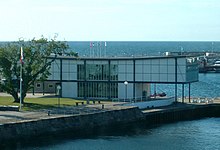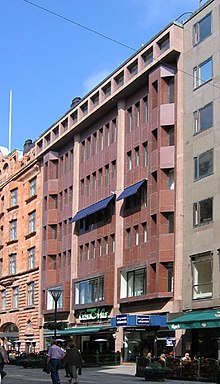Carl-Axel Acking
Appearance
You can help expand this article with text translated from the corresponding article in Swedish. (March 2024) Click [show] for important translation instructions.
|
Carl-Axel Acking | |
|---|---|
 Carl-Axel Acking with the model for the H55 exhibition pavilion | |
| Born | 8 March 1910 Helsingborg |
| Died | 12 June 2001 Lund |
| Resting place | Djursholms Begravningsplats |
| Occupation | Architect |


Carl-Axel Acking (March 8, 1910 – June 12, 2001) was a Swedish architect, author and furniture designer, winner of the Lunning Prize in 1952.[1][2]
Notable works
[edit]- 1950 Siris kapell in Torsby
- 1955 Hässelby Familjehotell in Stockholm
- 1956 "Quality Hotel" Östersund
- 1965 Skånska banken och Kreditbanken på Södergatan i Malmö
- 1970 Telefonstation Bellevuegården in Malmö
- 1972 Birgittakyrkan in Skön
References
[edit]- ^ Uggla, Marianne (1986). The Lunning Prize. Nationalmuseum. pp. 42–45. ISBN 978-91-7100-297-6.
- ^ "Zweedse designers in de kijker: Acking, Jakobsson en Ekström". Imagicasa (in Dutch). Retrieved 2022-12-30.
External links
[edit]![]() Media related to Carl-Axel Acking at Wikimedia Commons
Media related to Carl-Axel Acking at Wikimedia Commons
